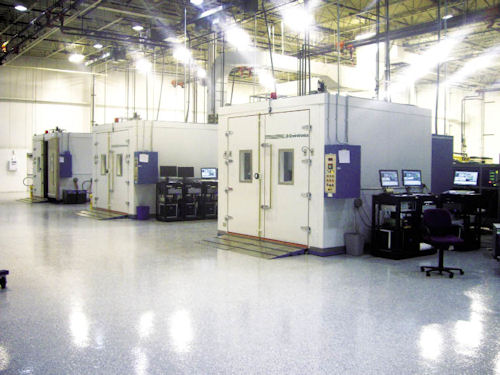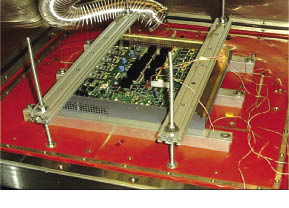Latest News
December 1, 2012
By Debbie Sniderman
Simulation is great for an optimized design process, but where do different types of testing methods fit into an efficient design cycle? How can testing be integrated into a lean design cycle without holding things up? Where can test results still provide value without forcing designers to start all over?
 |
| Intertek’s environmental chambers are used to prepare products before testing to meet requirements outlined in standards or test plans. Image courtesy of Intertek. |
The Right Tests
Through simulated “real-life” conditions, accelerated stress testing will provide the data necessary to evaluate recent or proposed product changes. Accelerated stress testing can save both time and money for various applications without making the setup and test execution complex.
There are a large range of tests, up to a dozen types depending on how you break them down. According to Alexander Porter, senior chief engineer of Programs, Performance and Durability at Intertek, what is important is the goal of the information you want to gather, not the test method.
“Rather than focus on the test or the equipment, start with the information,” he suggests. “What is the key piece needed to move a product forward? Then choose a task and choose the equipment.”
Porter says thermal and vibration are the two main stressors typically tested. Vibrations are a key source of damage in almost every application. But, vibrations are not the same in every environment. There is no one-size-fits-all test for vibration. At Intertek, a variety of single-axis electro-dynamic machines and three types of 6-axis vibration machines create appropriate vibration spectrums. If testing doesn’t activate the right frequencies, you can miss significant failure modes.
Thermal testing is a little easier to do. It usually involves an environmental chamber with radiant heat sources such as light banks and environmental controls. Combined temperature and vibration testing cover most of the failure modes.
Another test is for contaminants, which Porter says is very important for computer modeling.
“One thing that is difficult or impossible to quantify is the effect of dust, salt, water spray or other contaminant sources on a product,” he says. “If you don’t test it in a lab, you won’t discover it until it’s in the field. Individually, these tests may not precipitate a failure, but they are usually a catalyst that precipitates failure faster when combined with temperature or vibration.”
The Right Time
“The best time for temperature, vibration, electrical, and contaminant testing is on the very first prototype,” Porter continues. “If the goal is to optimize the design, first brainstorm the potential sources of damage, then determine which of those sources will likely include vibration, temperature, contaminants, actuation, and voltage. We choose which to use and build a HALT (highly accelerated life test) style test or a FM (failure mode) verification test from those results.”
If components or subsystems are available early, or if it is a carryover product, Intertek can take a current production model and modify it on the bench.
“The earlier a part is available for testing the better, so they (design engineers) can iterate faster,” he explains.
The primary goal of accelerated testing early in development is to help companies identify what information they need and what test will produce that information in the shortest time. Porter says most companies know what challenge they’re facing but not what test they want. They think they want a test because they’ve always done it.
“It’s important to drill past this to decide what assumptions they’re trying to validate or decision they’re trying to make. Don’t just blindly test,” he cautions.
There are two opportunities for product failure during the design phase, from either flaws in the design or lack of design margin. The goal of highly accelerated life testing is to increase the thermal and vibration margins of a design. It does so by stimulating failures, not simulating them.
HALT can shorten the time to market and reduce development costs compared to traditional qualification and design verification testing. Marginal designs may not be observable until a sufficient number of units are in the field. With increased volumes come increasing variations. HALT helps discover marginal systems, and can be used in the design stage before failures occur in the field during customer use and it is too late to redesign.
Why Run HALT During Design
“There’s no doubt when you’re trying to get things done as fast as you can, simulation before you have prototypes in hand is a good way to start identifying problems,” says Neill Doertenbach, senior applications engineer at Qualmark Corporation. “But in real life, by identifying areas where testing will be most valuable and targeting specific tests on sub-assemblies, the first units built, or on critical functions, we can quickly find out if there are design flaws.”
Qualmark, a manufacturer of accelerated reliability test equipment, primarily focuses on HALT testing to force failure modes to occur and to find the weakest parts in the design.
While HALT can test full assemblies or units nearing the end of production to help designers account for variations in component materials and manufacturing processes, it is also useful for pieces of the assembly early on during the prediction stage.
“The concept of taking a product or design and pushing it beyond spec until you find a failure is a step you take in the design phase,” says Tom Peters, director of the Qualmark Center of Excellence. “You can take the limits that you learn from HALT and use them to screen variance in supply or vendors. The one cliche we have found to be true: In theory, theory and practice are the same. In practice, they’re not.”
“HALT finds the low-hanging fruit, the subset of failure modes that are often the ones you don’t know about and that didn’t come out of the simulation,” Doertenbach says. “When ramping stresses to a high level, failures that occur from environment stresses wouldn’t come out of predictions that are based on component behaviors.”
 |
| A product fixed to a table with liquid nitrogen ducting in place and ready for Qualmark HALT testing. Image courtesy of Qualmark. |
During typical HALT testing, products are tested with independent and then combined stresses until forcing a failure. It’s an exploratory discovery process to find a weakness and understand the cause of the failure. Doertenbach says about a third of failure modes typically don’t show up until the final combined stress environment.
Peters says new or small companies that turn designs frequently find value in finding failures early to prevent them from becoming warranty issues. Companies that test to spec without HALT don’t know if their design is robust.
“HALT doesn’t give an indication of when a product will fail, unless it is tied in to accelerated life testing (ALT) or reliability growth testing (RGT),” Peters says. “If you do HALT first, then you get ALT and RGT with a more mature product. HALT speeds the standard reliability tests and ALT, and makes them less expensive because you fail fewer units. Those are expensive places to find design problems. Those tests should be a demonstration of reliability, not a troubleshooting process.”
By doing HALT first, companies can get results from ALT faster, because they’re not being delayed by failures that shouldn’t have been in there in the first place, says Peters. It also allows companies to make more accurate life predictions and plan for warranty expenses.
“Consumers today expect much higher reliability and better products without failures,” he says. “Traditional reliability and testing to spec can’t get a design to the reliability levels needed. We have to use a method that finds the failures that you don’t know about.”
Debbie Sniderman is an engineer, writer and consultant in manufacturing and R&D. Contact her at VIVLLC.com.
INFO
Subscribe to our FREE magazine, FREE email newsletters or both!
Latest News
About the Author
DE’s editors contribute news and new product announcements to Digital Engineering.
Press releases may be sent to them via [email protected].






